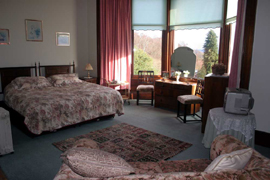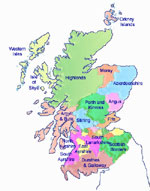![]() Email Arduthie House enquiries & reservations: bookscotland@madbookings.com
Email Arduthie House enquiries & reservations: bookscotland@madbookings.com
![]() Other places to stay in and around
Crieff
Other places to stay in and around
Crieff
 Welcome
to Crieff, at the Gateway to the Highlands
Welcome
to Crieff, at the Gateway to the Highlands
A family run guest house of great character overlooking Strathearn and
the Ochil Hills, well situated for golf, fishing or touring.
Spacious ensuite accommodation with TV, tea and coffee making facilities. Highly commended for food and serving the best in local produce.
Open all year.
Special breaks available, details on request.
The Arduthie is a licensed guest house, managed by resident proprietors,
who welcome visitors to share their home.
Our home is quietly situated on the edge of this historic market town
of Crieff, within a few minutes walk of all shops and amenities.
The outlook commands panoramic views of the magnificent Ochil Hills to
the South and beautiful scenery of this area.
Arduthie House Accommodation
We have 4 en-suite bedrooms, all of which are spacious and tastefully decorated, with central heating, tea/coffee making facilities and colour television.
A cocktail bar with the largest selection of malt whiskies in the area.
Welcoming log fires in the Winter or the chilly Spring and Autumn evenings.
A wide selection of wines at reasonable prices is always available.
The locality provides excellent facilities for all types of sport. The world famous Gleneagles golf course is only 9 miles drive with an abundance of other beautiful courses in the area, including Crieff's own golf course just a few minutes walk from the Arduthie.
Fishing and shooting are more than adequately catered for, and with several Munroes within easy driving distance even the keenest of mountain climbers will be kept busy.
Located at the bottom end of the town, Crieff Visitor Centre is set in
4 acres of its own grounds, and boasts a children's play area for all
ages.
Some of the attractions at the centre include:
· Pottery
· Paperweights
· Highland Drovers Exhibition
· Restaurant
· Garden Centre
· Gift Shop
Local attractions:
The historic holiday town of Crieff is situated right in the heart of
Strathearn, and its central location provides an excellent base for exploring
many of Scotland's major attractions.
Drummond Castle Gardens, pictured right, is a very popular place to visit,
and is just a few miles drive from the hotel.
Described as one of the finest formal gardens in Europe, the Gardens were first laid out in the early 17th century by John Drummond, the 2nd Earl of Perth and include a John Mylne sundial erected in 1630. The gardens were renewed in the 1950s by Phyllis Astor, preserving features such as the ancient yew hedges and the copper beech trees planted by Queen Victoria to commemorate her visit in 1842. Open Easter weekend and then May to October 2pm-6pm. Castle not open to the public.
At Scotland's oldest distillery, the Glenturret, visitors can experience
the production process involved in distilling whisky. Built in 1775, the
distillery operated until 1923 when it was closed down. It was restarted
in 1959 by James Fairlie and has been producing ever since.
The distillery is located at 'The Hosh' just outside Crieff (view map).
Opening times are Monday-Sunday 10am-6pm, with the last tour at 4.30pm.
The distillery only close on 25th and 26th of December.
Directions:
BY CAR - The main route north is the A/M74. South of Glasgow take the
M73 to the A/M80 (the Stirling/Perth road), which joins the M9/A9. Then
take the A822 signposted to Crieff.
From Glasgow take the A/M80 as above.
From Edinburgh either the M90 to Perth (via Forth Road Bridge) then the
A85 from Perth to Crieff (signposted Crianlarich) OR the M9 to Stirling
and Dunblane.
BY BUS - There are direct services from all parts of the UK to Perth.
Then take bus to Crieff. The Arduthie House is the 2nd stop when you get
to Crieff.
BY TRAIN - There are trains from all UK main line stations (via Edinburgh
or Glasgow) to Perth.
BY AIR - To Edinburgh, Glasgow or Dundee airports and then by hire car
or taxi, or train to Perth.
About Crieff:
Crieff is the main town of Strathearn lying on the southern edge of the
Scottish Highlands. It has been a holiday resort since Victorian times
and is the second largest town in Perthshire with a population of almost
6000.
The town spills from the Knock, the wooded hill above, down to the River
Earn. James Square with it's fountain marks the centre of the town. There
are a number of tourist attractions such as Crieff Visitor Centre, Glenturret
Distillery (Scotland's oldest) and hotels including the grand Victorian
spa - the Crieff Hydro.
Macrosty Park, Crieff was opened in 1902. It is named after it's benefactor,
James Macrosty, who was Provost of the town.
The park is one of the most picturesque in Scotland, with a fine collection
of mature specimen trees and the Turret Burn flowing through it. The Victorian
bandstand, gifted by the brother of James Macrosty, has brass band concerts
in summer.
There are a variety of activities and two childrens' play areas. A number
of picnic tables are placed around the park, making it an ideal place
for a day out in fine summer weather.
Lady Mary's Walk was gifted to the town in 1815 by Sir Patrick Murray
of Ochtertyre. The walk was a favourite of his daughter, Lady Mary.
A beautiful beech lined avenue runs alongside the River Earn for about
1500m. There is considerable variety of trees, plants and wildlife to
observe on this fine walk.
Once an ancient cattle market and Scottish 'frontier town' where Highlanders
would come for the great cattle trysts. Cattle were driven from all over
the north of Scotland to be sold to lowland buyers. Montrose, Rob Roy
Macgregor, Bonnie Prince Charlie, Robert Burns and many others from Scotland's
colourful history have walked Crieff's historic High Street.
Crieff is derived from craobh, the Gaelic for "among the trees"
and began to be seen in documents dating from the 12thC and was granted
its Charter in 1218.
We have only glimpses of life in these times from documents but the town
had a mill by 1444. Drummond Castle, 4 kms south of Crieff, was founded
in 1491 by Sir John Drummond under license from James IV.
Powerful local families fought each other. In 1511 in the old church of
Monzievaird just west of the town, 'many' Murrays along with their families
were burnt when Drummonds and Campbells set the building alight.
By mid 17thC a road existed south to Dunblane and the River Earn was
probably first bridged around 1660. In 1672 Crieff became a burgh of barony.
The town held the country's most important cattle market and was famous
for hanging lawless Highlanders! Rob Roy Macgregor visited the town on
many occasions, often to sell cattle.
In 1716 Jacobites burnt the town on their way back from the battle of
Sheriffmuir.
The huge cattle sales continued to take place. In 1723 30,000 cattle sold
at one great fair with many driven south 800km to Smithfield in London.
Around 1730 a military road was driven from Tummel Bridge in the north
and in 1742 the road was further improved to take carriages north via
the Sma' Glen.
In 1731 James Drummond, 3rd Duke of Perth, laid out the town's central
James Square and establishing a textile industry with a flax factory.
Bonnie Prince Charlie held his last war council in the Drummond Arms Hotel
before he was finally defeated at Culloden in 1746.
After 1746 Rebellion the Drummond estates were forfeited to the Crown
until 1784. The Commissioners who were in charge continued to develop
Crieff as an industrial centre based on tanning and bleaching. In 1748
there were no less than 5 breweries and a paper making factory was opened
in 1763.
In 1775 Glenturret Distillery opened.
Although cattle markets continued, the huge sale held each October, the
Tryst, moved to Falkirk in 1770.
The town was involved in the cotton industry - yarn was bought in Glasgow,
garments woven locally and returned for sale. In 1770 the hand-loom weavers
organised themselves into a Society and in 1786 a Weaver's Hall was erected
in Commissioner Street.
Mains gas became available in the town from 1842, the same year that
Queen Victoria visited. The railway arrived in 1856 and mains water was
laid from 1872. The Hydro Hotel was built in 1868. In 1922 the Crieff
Electric Supply Company began generating and provided some electric lighting
locally.
The fifties saw the last cattle markets. An event which marked the end
of centuries of 'trysts'. In 1951 the last passenger trains ran from Perth.
Rail buses operated for a while but in 1964 the line closed completely.
![]() Email Arduthie House enquiries & reservations: bookscotland@madbookings.com
Email Arduthie House enquiries & reservations: bookscotland@madbookings.com
